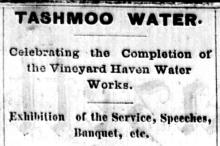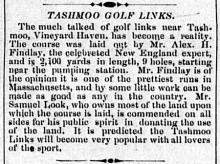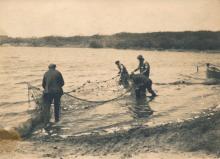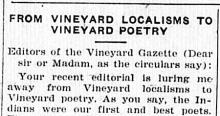The Indians of Martha’s Vineyard - so said a writer in the columns of the Gazette not many years ago - were our first and best poets.
One proof of this is the naming of that one of the Island’s ponds that most appropriately belongs in the classification of lake, and that has oftenest been compared to Killarney, both by those who refer only to the Irish lake as a worldwide criterion of beauty.
Tashmoo is the Vineyard lake, and there is no record of any visitor who failed to express pleasure at the music and poetry of the name, and its application to the sheet of water, framed within green trees and against the distant water of Vineyard Sound, which may be seen by any traveler of the main highway from Vineyard Haven to West Tisbury.
The writer who referred to the Indians as poets was the late Charles H. Brown. They lived close to nature, he went on. “They did not borrow their language as we have done. They made it, advancing from the concrete to the abstract by singing flights of fancy.
“Their Clumsy, Prentice Hands”
“What a pity it is that our Puritan ancestors could not justly weigh the mine and thine. They had a poesy of their own, Milton and Bible, but when they dealt with the poesy of others they, in England, shattered the pictures of saints in sunlit windows and overturned carved altars.
“In America, they tried their clumsy, prentice hands and their misfit Roman alphabet at transcribing beautiful Indian words. The worst offender was the Rev. John Eliott, Apostle to the Indians, who translated the Bible into Algonquin. ‘He had some Greek and Latin and was not a stranger to Hebrew,’ and mispronounced all three.”
Mr. Brown cited as an example of an Indian name misrepresented: Mattapaquattonooke, sometimes defined as “Mat-ta-pau-quet-tah-hun-auke,” and meaning “bad, broken up land.” But a legislative clerk who took the testimony of Indians spelled the word “Mattapaquaha,”
“Mark the difference between men with pens and a man with an ear,” wrote Mr. Brown. Years ago, he said, he had asked the late Prof. Edward S. Burgess the meaning of the word Tashmoo.
“He said that in its original form it was a whole sentence, Kata-co-tissi-moo, meaning “there is here a great spring of water.” Undoubtedly this is a good, literal translation. Later I found Mr. Marshall Shepard, the President of your Historical Society, at his home.
With the Help of a Lexicon
“He was working on the same word with the help of an Indian lexicon. I asked him for his translation and he said “in this place the heart is lifted up.” Think of the beautiful metonomy from a spring to a heart! I hate that word metonomy. Let us say, that flight of fancy from things to thoughts.”
Seeking to express the beauty of Tashmoo for the ear and heart, Mr. Brown chose words such as Longfellow said the Indians used, “so plain and childlike scarcely can the ear distinguish whether they are snug or spoken.” Recalling an old deed by which Nicolas Tissimoo, an Indian, had conveyed land at “Cotissimoo” to Richard Sarson and others, Mr. Brown went on to shape these lines:
“Now to the spring the birds of Springtime come.
A’top the cato’ninetails blackbirds sing,
On maple branches robins build their nests,
Beside the spring the pinkletinkes trill.
Now from his lodge old Nicholas comes out
And, lifting up his voice, he sings with them,
“We like this spring, our hearts have overflowed.”
Lord it is I, Kata co tissi moo.”
Overlooking Tashmoo from the landward side is Tashmoo Farm - great rolling country, wide stretchers of meadowland, immense tracts of woodland” - all so oriented that the aim of the settlers as well as of nature might have been to frame a view and an approach to the blue waters. The farmhouse of Tashmoo - mansion house, it was called in the old days - was built by Samuel Look in 1769, and for more than 200 years the house and farm remained in the Look family.
From the Great Springs
From the great springs water was first pumped to supply the town of Vineyard Haven in 1887, and a celebration was held in honor of the event. The next summer the Sons of Martha’s Vineyard foregathered in the pines near the lake for a reunion, and in those years a reunion of the Sons was quite an event. Perhaps the most felicitous note was struck by Ichabod Norton Luce who proposed the toast - a fresh water one - in this fashion: “Tashmoo, breathes there the man who never to himself hath said, Tashmoo.”
Then up spoke Augustus L. Holmes of Tisbury, and spoke as follows:
“There is an old Greek legend that Orpheus played such sweet music that the rocks followed him, the trees bowed their heads in homage, the running brooks stayed their course to listen to his celestial strains. Just reverse this experience and you have the experience of myself today.
“In the rustling of the trees I hear the whisper of some fair goddess, in the gentle murmur of Tashmoo I catch the enchanting accents of some lovely water nymph, the rocks and fields around me seem animated by a divine impulse and, if I could, I would remain in silent homage and let their strains entrance you as they do me...”
In his volume, Martha’s Vineyard the late C. G. Hine set forth a fanciful legend of Tashmoo, the only fault of which was its absence of foundation in fact.
“It has been handed down,” Mr. Hine wrote, “how Pohogonot, the old sachem who once ruled the sand dunes of Squibnocket, gave to his son Tashmoo this distant portion of his domain, and how Tashmoo whose mother, Quampeche, was a seeress possessed of the gift of knowing things, was told by the old lady of beautiful springs of pure water which would mark the end of his journey, and given a white shell with which he was to drink therefrom and give his name to the land...”
Musical Personifications
The Indians never mingled place named with the names of persons, but this “legend” brings together some musical personifications.
More earnestly Mr. Hine wrote, “The unsentimental geologist tells us that Lake Tashmoo or Chappaquansett, as it is also called, was originally an arm of the sea that recently (geologically recently - for to geology a thousand years are as a day) has been barred from the open water by walled beached and that this valley, the bottom of which is filled with sweet waters, and whose higher depression, crossed by the highway, continues to the southward, was probably carved by the erosion of a sub-glacial river.”
In modern times Tashmoo has again been made an arm of the sea, for it is open through a channel to Vineyard Sound. But it remains nevertheless a lake in the character and in its loveliness, and the great springs still flow, and the heart is lifted up.










Comments